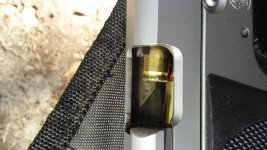I'm going to give the factory one more shot at it. If that doesn't work out, I'll possibly just sell this one. I've never liked that trigger guard. It digs into my finger. Maybe try the newer style.
This an older square trigger guard gun? We were told the early 3rd gen's were made on the older equipment, meaning some of the cuts were made using hand-controlled equipment. This included the extractor spring wells (holes). That was said to explain some of the early potential for differing tolerances and the need for different springs to get the tension within the right spec.
We were also told that if the older repair extractor spring kit (nested springs, part number 19134) was needed, it might also be the case that the resulting spring tension might end up being heavier than the normal upper range for the 69/59 guns, but this had to be approached with caution. This was reinforced when I was talking to a guy at the Springfield plant who used to work in Pistol Repair. Once the 3rd gen production and repair was moved to Houlton, I have no idea if anyone wanted to move there from Springfield to work in production or pistol repair.
We were warned to be careful in having to use the heavy tension to repair an older 3rd gen double stack 9, as too light and you could get continuing failures-to-extract, but too heavy and you might get failures-to-feed (tight extractor). I knew of 2 guns that had to have the tension pushed a pound or two over the normal upper range, but both fed and functioned just fine after repair using the old extractor spring kit. Looked like the earlier armorer instructors and repair techs knew what they were talking about.

(I suspect those folks are retired by now.)
FWIW, as the newer 3rd gen's were being produced (think post introduction of MIM), they were buying and using new machinery and equipment, and revisions were being slip-streamed into production all the time. I remember being told that at one point the 5906/03TSW barrels received a minor revision (aside from thicker barrel hoods and delayed unlocking cam profiles) in the chamber wall. It reportedly involved a minor change of angle in the walls of one degree, but it was supposedly done to help improve extraction if some "generous" ammunition case tolerances occurred (too tight in chamber upon expansion) that might've made for sticky extraction in older barrels.
From what I was told, the change was indicated by the alpha/numeric marking on the barrel hood in the TSW's, with the previous (smaller) "9mm Parabellum" being replaced with (larger) 9MM alpha/numeric script.
The later production 5906TSW's were refined and outstanding versions of the original 5906.
Good luck, and let us know how it works out.
If you lived closer to me (in CA), so you could bring it by in person, I'd offer to inspect and repair it as a courtesy. The last few older 3rd gen's in which I've replaced extractors were an early production 3913 & 6906, and a newer 3913TSW (which the owner was seriously always trying to wear out, shooting it damned near everyday on his own range). All 3 of them were still feeding and functioning fine, but when inspecting them I saw that chipping was starting to show on the old extractor hooks, and one of them had extractor spring tension that was too light (but still working when he shot it for quals). All 3 fed and fired just fine with newly filed & fitted extractors and fresh springs.

